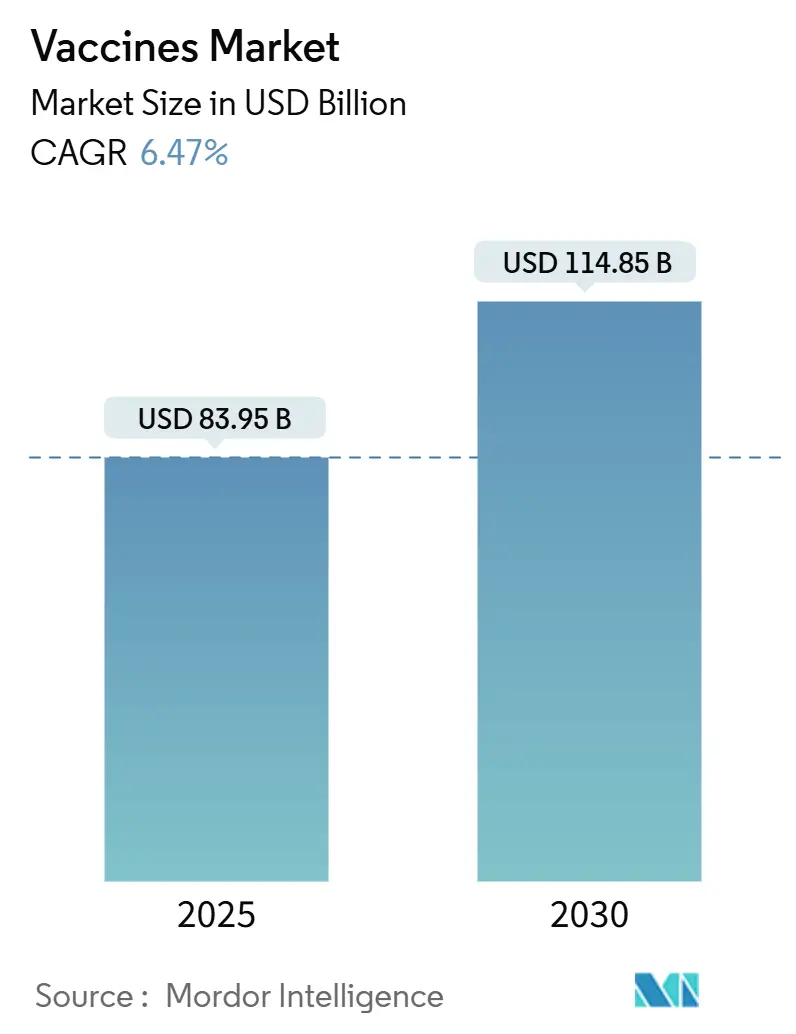
| Study Period | 2019 - 2030 |
| Market Size (2025) | USD 83.95 Billion |
| Market Size (2030) | USD 114.85 Billion |
| CAGR (2025 - 2030) | 6.47 % |
| Fastest Growing Market | Asia Pacific |
| Largest Market | North America |
| Market Concentration | Medium |
Major Players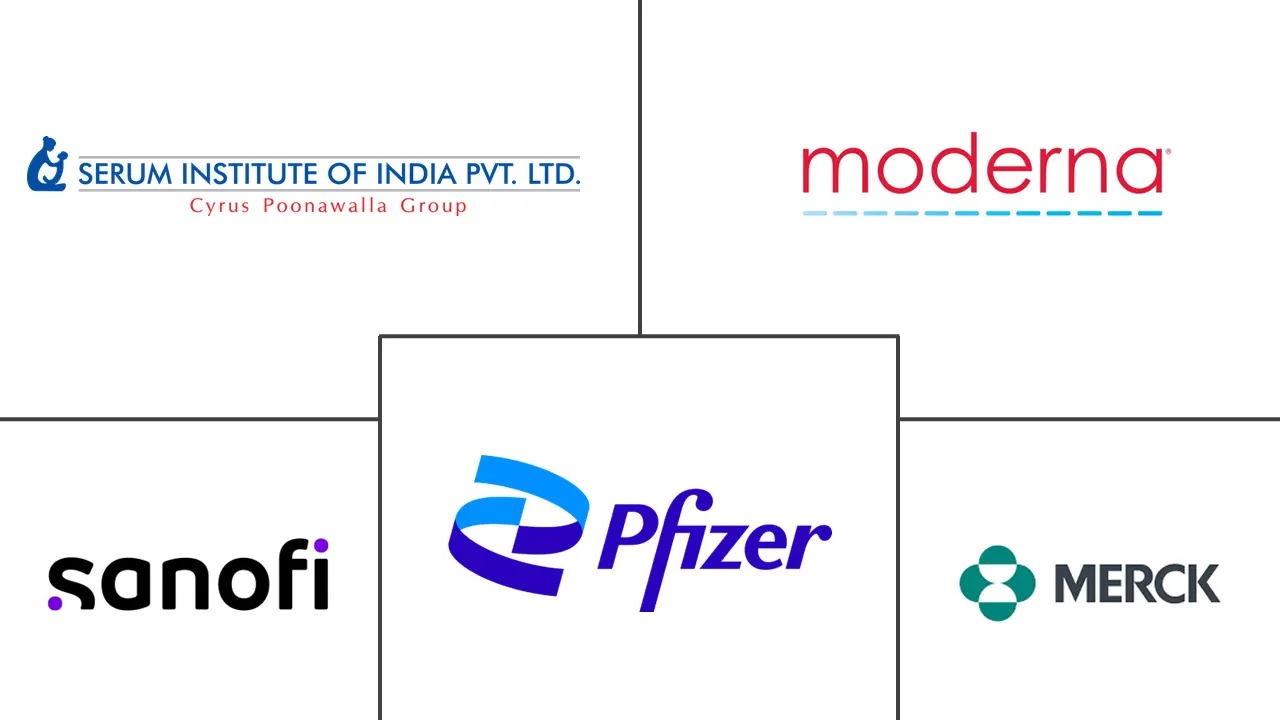
*Disclaimer: Major Players sorted in no particular order |
Vaccines Market Analysis
The Vaccines Market size is estimated at USD 83.95 billion in 2025, and is expected to reach USD 114.85 billion by 2030, at a CAGR of 6.47% during the forecast period (2025-2030).
Vaccines Market Overview
The vaccine industry has witnessed significant consolidation and investment activity, with pharmaceutical companies strategically positioning themselves through mergers, acquisitions, and funding rounds. In September 2024, UK-based Vicebio secured approximately USD 100 million in Series B funding to develop cost-effective vaccine technologies, highlighting continued investor confidence in innovative vaccine platforms. The industry has also seen increased collaboration between established pharmaceutical companies, with several major licensing agreements and strategic partnerships announced in 2024, including the restructuring of CureVac's partnership with GSK in July 2024, in a deal potentially worth €1.45 billion plus royalties.
Manufacturing capabilities and supply chain resilience have become critical focus areas for the industry, with companies investing heavily in expanding production facilities and modernizing infrastructure. Leading manufacturers are adopting advanced production technologies and automated systems to enhance efficiency and quality control. For instance, in March 2023, CSL Limited inaugurated a state-of-the-art vaccine R&D facility in Massachusetts, the United States, specifically designed to leverage next-generation technologies for vaccine development. Additionally, approximately 35 vaccine-producing countries have achieved maturity levels sufficient to oversee development, manufacturing, and release processes, according to recent WHO assessments.
The technological landscape continues to evolve rapidly, with significant advances in vaccine delivery systems and formulation techniques. Companies are increasingly exploring alternative delivery methods, including oral and nasal applications, to improve vaccine accessibility and effectiveness. This trend is exemplified by Bharat Biotech's successful launch of iNCOVACC, an indigenously developed nasal vaccine, in January 2023. The industry has also witnessed substantial investment in novel platforms, with the U.S. government allocating over USD 500 million in June 2024 to Project NextGen for developing innovative vaccine delivery methods, including nasal sprays and oral formulations.
Global health initiatives and cross-border partnerships have emerged as crucial drivers of vaccine accessibility and distribution. In February 2024, UNICEF expanded its collaboration with Africa CDC to strengthen supply chain management and immunization services across the African continent. The industry faces significant challenges in addressing global health needs. For instance, as of April 30, 2024, WHO's Global Dengue Surveillance reported over 7.6 million dengue cases worldwide, including 3.4 million confirmed cases and more than 16,000 classified as severe. These statistics have prompted increased focus on developing comprehensive vaccination programs and improving distribution networks, particularly in regions with limited healthcare infrastructure.
Vaccines Market Trends
Focus on Vaccine Development and Launches
The vaccine industry has witnessed significant momentum in research and development activities, with major pharmaceutical companies investing heavily in innovative vaccine technologies and launching new products. Leading companies are expanding their vaccine portfolios through internal development programs and strategic collaborations to address unmet medical needs. For instance, in June 2024, Pfizer received US FDA approval for CAPVAXIVE, its 21-valent pneumococcal vaccine, demonstrating the industry's commitment to developing more comprehensive vaccine solutions and highlights the commercial potential and market demand for novel vaccines.
Major industry players are increasingly entering into licensing agreements and partnerships, underscoring the heightened focus on vaccine development. For instance, in December 2024, the International AIDS Vaccine Initiative (IAVI), a nonprofit dedicated to tackling pressing global health issues like HIV and tuberculosis, teamed up with the Institut Pasteur de Dakar (IPD). The IPD, also a nonprofit, champions equitable and affordable health access in Senegal and beyond. Together, they've inked a deal to collaborate on vaccine development, manufacturing, and ensuring access across Africa. Additionally, companies are increasingly investing in manufacturing capabilities to ensure adequate supply, as demonstrated by the partnership between Biovac and Sanofi in June 2024 for producing inactivated polio vaccines across more than 40 African countries.
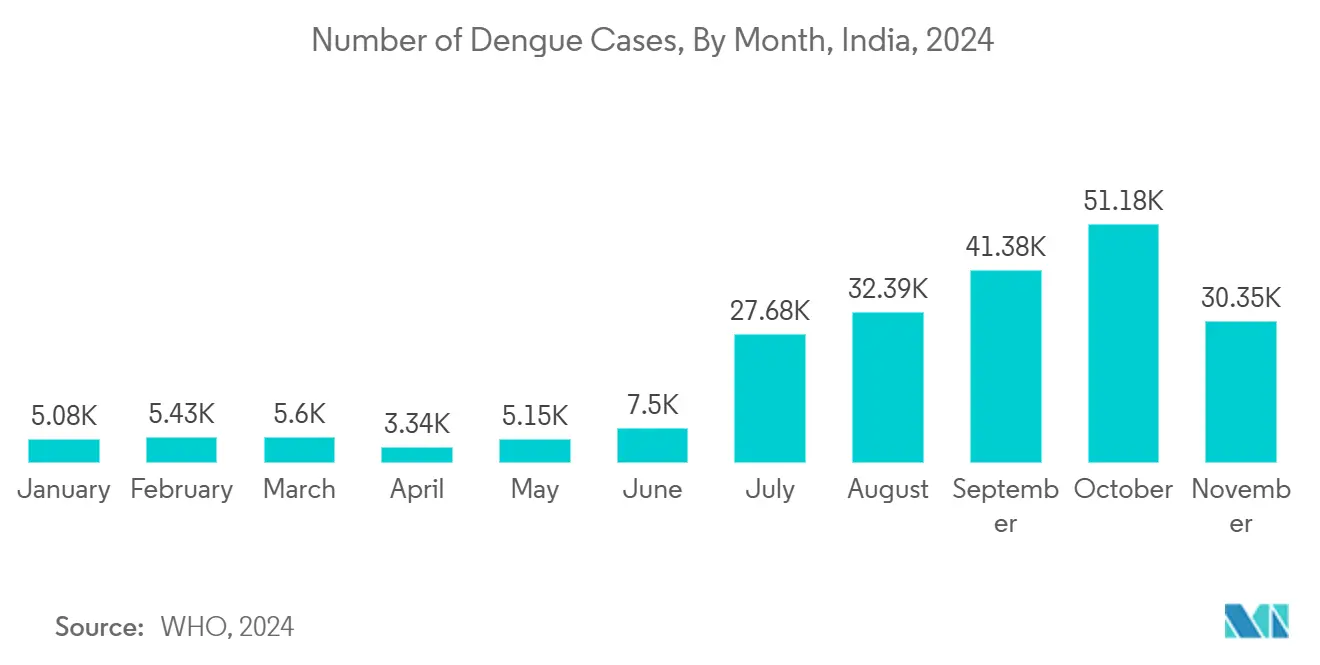
Rising Prevalence of Infectious Diseases
The global healthcare landscape continues to face challenges from both existing and emerging infectious diseases, creating an urgent need for effective vaccines. According to the World Health Organization's report in January 2023, approximately 64 new infectious diseases were identified as affecting populations globally, highlighting the continuous emergence of novel pathogens that require preventive solutions. The severity of this situation is further emphasized by the fact that around 2 million people are hospitalized annually due to rotavirus infections alone, demonstrating the substantial burden that vaccine-preventable diseases place on healthcare systems worldwide.
The increasing prevalence of infectious diseases is particularly concerning in developing regions, where factors such as population density, urbanization, and climate change contribute to disease transmission. Healthcare organizations and governments are responding to these challenges by implementing comprehensive disease surveillance systems and strengthening their response capabilities. The emergence of new pathogens and variants of existing diseases has prompted pharmaceutical companies to develop more sophisticated vaccines that can provide broader protection against multiple strains, as evidenced by the development of multi-valent vaccines targeting various disease strains simultaneously.
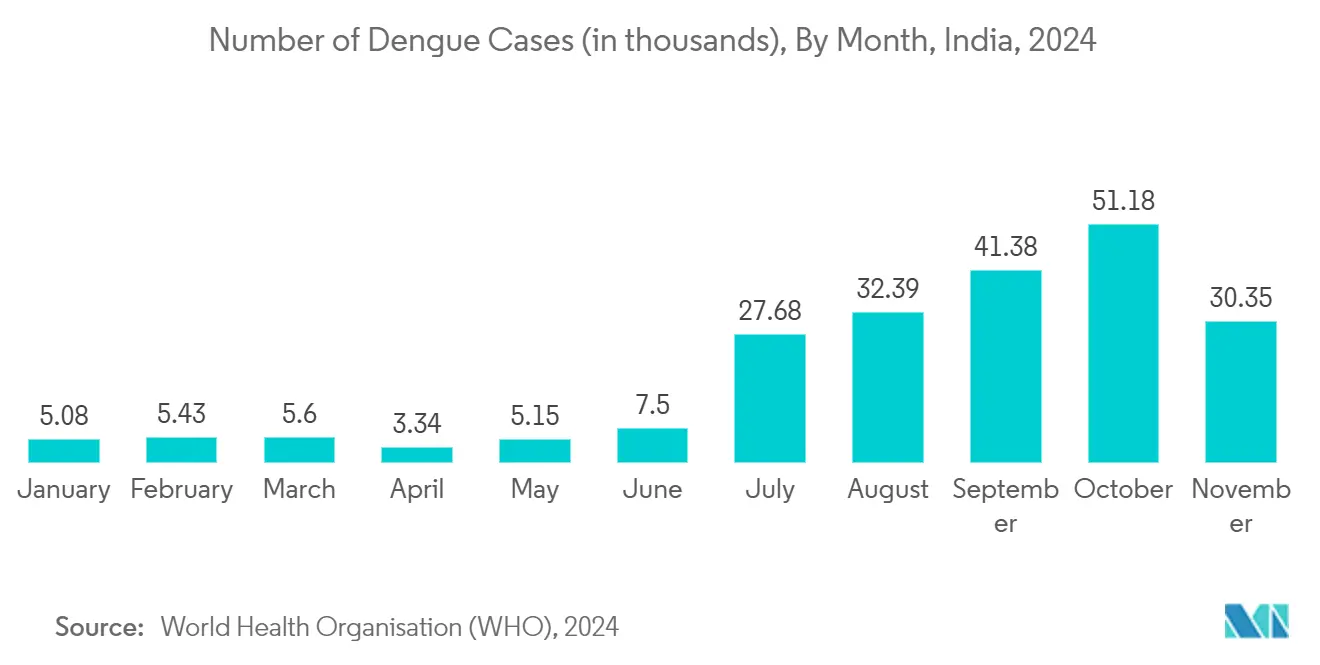
Increasing Immunization Programs
Global immunization initiatives have gained significant traction as countries recognize vaccination as a cost-effective public health intervention. The World Health Organization reported a positive trend in vaccination coverage, with measles vaccination rates increasing from 81% in 2021 to 83% in 2023, and first dose of HPV vaccine in girls grew from 20% in 2022 to 27% in 2023, demonstrating the growing success of immunization programs worldwide. These programs are becoming more comprehensive, targeting not only traditional childhood diseases but also expanding to address adolescent and adult vaccination needs, creating a more holistic approach to disease prevention across all age groups.
International organizations and governments are strengthening their commitment to immunization programs through increased funding and improved healthcare infrastructure. A prime example is India's partnership with Gavi in February 2023, which allocated USD 250 million specifically for identifying and vaccinating children who haven't received any vaccines while also supporting the introduction of new vaccines like HPV and typhoid conjugate vaccines into the national immunization schedule. Such initiatives demonstrate the growing recognition of vaccination as a fundamental component of public health strategy and the willingness to invest in comprehensive immunization programs.
Advancements in Vaccine Technology
The vaccine industry is experiencing a technological renaissance with breakthrough innovations in vaccine development platforms and delivery systems. Companies are investing in novel technologies such as next-generation sequencing, artificial intelligence, and advanced manufacturing processes to enhance vaccine efficacy and production efficiency. These technological advancements have enabled the development of more sophisticated vaccines that can target multiple disease strains simultaneously and provide longer-lasting immunity, as demonstrated by the emergence of multi-valent vaccines and novel delivery platforms.
The integration of cutting-edge technologies has also revolutionized vaccine manufacturing processes, making them more efficient and scalable. For instance, the advancement in recombinant DNA technology and cell culture techniques has enabled the production of safer and more effective vaccines while reducing production timelines. Additionally, innovations in vaccine delivery systems, such as needle-free technologies and thermostable formulations, are addressing critical challenges in vaccine distribution and administration, particularly in regions with limited cold chain infrastructure. These technological improvements are not only enhancing vaccine effectiveness but also making vaccination programs more accessible and feasible in diverse geographical locations.
Vaccines Market Technology Segment Analysis
mRNA Vaccines Segment in the Vaccines Market
The mRNA vaccines segment has emerged as the dominant technology in the global vaccines market, commanding approximately one third market share in 2024. This substantial market position is primarily attributed to the widespread adoption of mRNA-based COVID-19 vaccines and continued technological refinements. The segment's leadership is reinforced by significant investments in manufacturing infrastructure and cold chain capabilities designed explicitly for mRNA vaccine production and distribution. Major pharmaceutical companies have expanded their mRNA vaccine portfolios beyond COVID-19, exploring applications in cancer immunotherapy and other infectious diseases. Shorter production timelines further support the segment's success compared to traditional vaccine technologies and the ability to modify vaccine compositions in response to new variants rapidly. Additionally, ongoing research and development initiatives have improved the stability and storage requirements of mRNA vaccines, making them increasingly practical for global distribution.
Viral Vector Vaccines Segment in the Vaccines Market
The viral vector vaccines segment is projected to experience the highest growth rate in the vaccine market. This remarkable growth trajectory is driven by increasing applications in both preventive and therapeutic vaccines, particularly in oncology and rare diseases. The segment's expansion is supported by improved manufacturing processes that enhance production efficiency and reduce costs. Technological advancements in vector design and genetic modification capabilities have significantly increased the effectiveness and safety profile of these vaccines. The segment is benefiting from growing regulatory acceptance and successful clinical trials across multiple therapeutic areas. Furthermore, strategic collaborations between biotechnology companies and research institutions are accelerating the development of novel viral vector-based vaccines. The versatility of viral vectors in delivering genetic material and their ability to induce potent immune responses continue to attract substantial investment and research focus.
Vaccines Market Type Segment Analysis
Multivalent Vaccines Segment in the Vaccines Market
The multivalent vaccines segment has emerged as the dominant force in the global vaccines market, primarily attributed to the segment's ability to protect against multiple strains or types of pathogens in a single vaccination. The cost-effectiveness and convenience of multivalent vaccines have made them particularly attractive for national immunization programs and healthcare providers. The successful implementation of combination vaccines in pediatric immunization schedules worldwide further reinforces the segment's strength. Recent technological advancements in vaccine development have enhanced the efficacy and safety profiles of multivalent vaccines, contributing to their market leadership. The segment's growth is also supported by increasing government initiatives promoting comprehensive vaccination coverage and the rising demand for vaccines that can address multiple disease strains simultaneously.
Monovalent Vaccines Segment in the Vaccines Market
The monovalent vaccines segment is projected to experience the highest growth rate in the vaccine market. This remarkable growth trajectory is driven by the increasing demand for targeted immunization solutions and the emergence of new infectious diseases requiring specific vaccine responses. The segment's expansion is further fueled by advances in precision medicine and the development of highly specialized vaccines for particular pathogen strains. Recent technological breakthroughs in vaccine development platforms, particularly in mRNA technology, have significantly enhanced the potential for monovalent vaccine development. The segment's growth is also supported by increasing investments in research and development for single-pathogen vaccines, especially in response to emerging viral threats. The trend toward personalized medicine and the need for specific immune responses in certain patient populations continue to drive innovation in this segment.
Vaccines Market Disease Segment Analysis
Pneumococcal Disease Segment in the Vaccines Market
The Pneumococcal Disease segment has emerged as the dominant force in the global vaccines market, commanding approximately one-fourth of the market share in 2024. This leadership position is primarily attributed to the widespread implementation of mandatory vaccination programs across both developed and developing nations. The segment's prominence is further reinforced by the high value of pneumococcal conjugate vaccines and their proven efficacy in preventing invasive pneumococcal diseases. The robust reimbursement policies in major markets, coupled with increasing awareness about pneumococcal disease prevention, have significantly contributed to this segment's market dominance. Additionally, the continuous development of more effective pneumococcal vaccines and the expansion of vaccination coverage in emerging economies have strengthened this segment's market position. The segment has also benefited from strong support from global health organizations and substantial investments in research and development for next-generation pneumococcal vaccines.
RSV Segment in the Vaccines Market
The Respiratory Syncytial Virus (RSV) vaccine segment is projected to exhibit the highest growth rate during the forecast period 2025-2030. This exceptional growth trajectory is driven by recent breakthrough approvals of novel RSV vaccines and the substantial unmet medical need in both pediatric and elderly populations. The segment's rapid expansion is further fueled by increasing awareness about RSV-related hospitalizations and the economic burden of the disease. Technological advancements in vaccine development platforms, particularly in mRNA and viral vector technologies, have accelerated the development of more effective RSV vaccines. The segment has attracted significant investment from major pharmaceutical companies, leading to a robust pipeline of candidate vaccines. Moreover, the successful commercialization of recently approved RSV vaccines has created a strong foundation for market expansion, particularly in high-income countries where the burden of RSV-associated healthcare costs is substantial.
Vaccines Market Route of Administration Segment Analysis
Parenteral Administration Segment in the Vaccines Market
The parenteral administration segment dominates the global vaccines market, holding approximately 75% of the market share in 2024. This substantial market position is primarily attributed to the widespread use of intramuscular injections in routine vaccination programs worldwide. The segment's dominance is reinforced by the fact that most established vaccines, including those for influenza, hepatitis, and COVID-19, are administered through this route. Healthcare professionals prefer this administration route due to its proven efficacy, precise dosing capabilities, and well-documented safety profile. The segment's strong performance is further supported by the extensive infrastructure and healthcare worker training already in place for intramuscular and subcutaneous vaccine delivery. Additionally, most new vaccine developments, particularly mRNA vaccines, continue to utilize this traditional administration route, further cementing its market leadership.
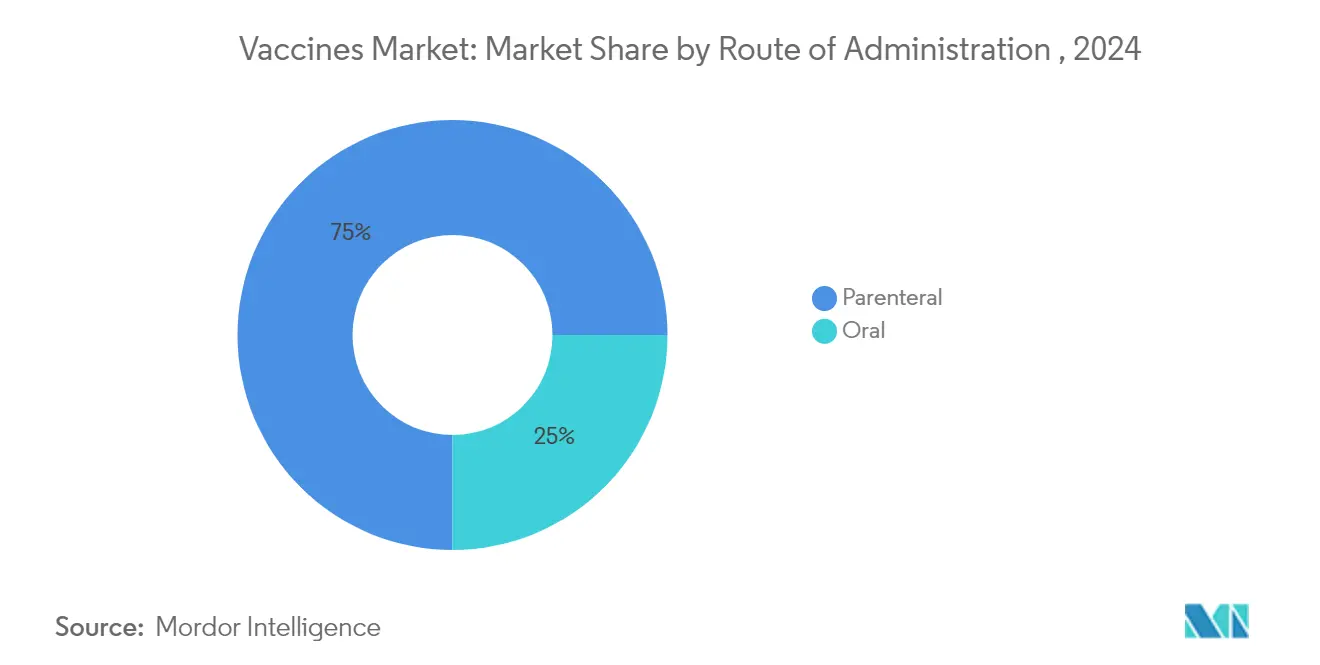
Oral Administration Segment in the Vaccines Market
The oral administration segment is emerging as the fastest-growing segment in the vaccine market, driven by increasing patient preference for non-invasive vaccination methods and technological advancements in oral vaccine formulations. The development of novel oral delivery systems, improved stability profiles, and enhanced bioavailability are contributing to this segment's rapid expansion. Healthcare providers are increasingly recognizing the benefits of oral vaccines, including easier administration, reduced need for trained healthcare workers, and improved patient compliance, particularly in pediatric populations. The segment also benefits from substantial research investments in oral vaccine development for various diseases, including polio and influenza. Recent successful launches of oral vaccines and ongoing clinical trials are expected to accelerate this segment's growth trajectory further.
Vaccines Market End-User Segment Analysis
Pediatric Vaccines Segment in the Vaccines Market
The pediatric vaccines segment dominated the global vaccines market in 2024, commanding more than half of the total market share. This substantial market presence is primarily attributed to well-established childhood immunization programs across both developed and developing nations. Comprehensive government support, mandatory vaccination schedules, and increased awareness among parents about the importance of childhood immunization further reinforce the segment's strength. The extensive coverage of diseases like MMR, DTP, and polio in pediatric vaccination schedules has significantly contributed to this segment's dominance. Additionally, the continuous introduction of new pediatric vaccines and combination vaccines has helped maintain the segment's leading position. The segment has also benefited from international organizations' initiatives to improve vaccination coverage in developing regions, mainly through programs like the Global Alliance for Vaccines and Immunization (GAVI) and UNICEF's immunization efforts.
Adult Vaccines Segment in the Vaccines Market
The adult vaccines segment is emerging as the fastest-growing segment in the vaccines market, driven by increasing awareness about adult immunization, particularly for diseases like influenza, pneumococcal disease, cancer, and herpes zoster. The segment's expansion is further fueled by the aging global population and their growing susceptibility to vaccine-preventable diseases. Recent technological advancements in vaccine development, particularly in mRNA platforms, have significantly enhanced the adult vaccine portfolio. The COVID-19 pandemic has also played a crucial role in highlighting the importance of adult vaccination, leading to increased acceptance and uptake of vaccines in this demographic. Additionally, the introduction of new vaccines targeting adult-specific conditions and the expansion of vaccination recommendations for different age groups have contributed to this segment's accelerated growth.
Vaccines Market Geography Segment Analysis
Vaccines Market in North America
North America represents a dominant force in the global vaccine market, driven by advanced healthcare infrastructure, robust regulatory frameworks, and strong government support for vaccination programs. The region benefits from the presence of major pharmaceutical companies, extensive research and development activities, and high healthcare spending. Both the United States and Canada have well-established immunization programs and favorable reimbursement policies that support vaccine adoption and distribution.
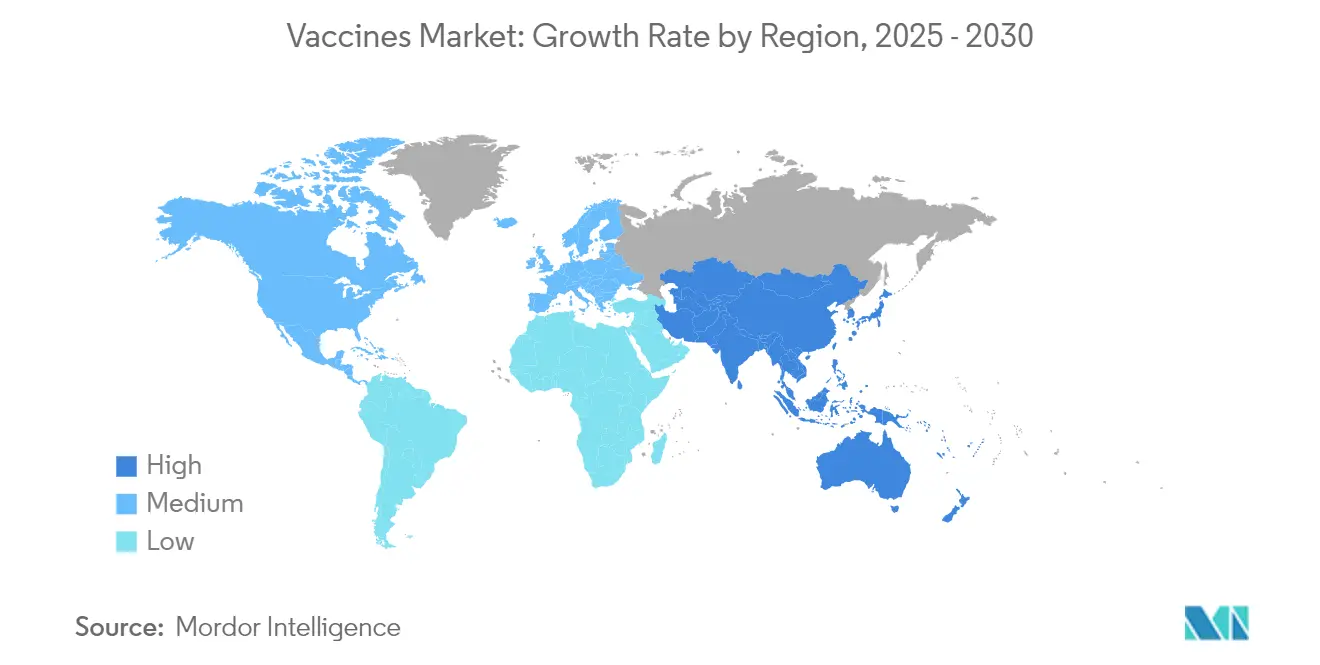
Vaccines Market in the United States
The United States leads the North American vaccines market, accounting for approximately two-thirds of the regional market share in 2024. The country's dominance is attributed to its sophisticated healthcare system, substantial investment in vaccine research and development, and strong presence of key market players. High vaccination rates, comprehensive immunization programs, and continuous technological advancements in vaccine development characterize the US market. The country's regulatory framework, spearheaded by the FDA, ensures rigorous quality standards while facilitating rapid approval processes for innovative vaccines.
Vaccines Market in Canada
Canada demonstrates remarkable growth potential in the vaccine market, with an expected CAGR of approximately 8% from 2025 to 2030. The country's market expansion is driven by its universal healthcare system, strong public health infrastructure, and increasing government initiatives to expand vaccination coverage. Canadian authorities have been actively working to strengthen their domestic vaccine manufacturing capabilities and reduce dependency on imports. The country's approach to vaccine procurement and distribution, coupled with its focus on preventive healthcare, positions it as a significant player in the North American market.
Vaccines Market in Europe
Europe maintains a strong position in the global vaccines market, supported by its advanced healthcare systems, robust research capabilities, and stringent regulatory standards. The region benefits from the presence of significant vaccine manufacturers, extensive clinical research facilities, and collaborative healthcare initiatives across countries. Key markets, including Germany, the UK, France, Italy, and Spain, contribute significantly to the region's market dynamics through their well-established vaccination programs and healthcare policies.
Vaccines Market in the United Kingdom
The United Kingdom emerges as one of the most prominent vaccines market in Europe, holding nearly a quarter of the regional market share in 2024. The country's market leadership is supported by its comprehensive National Health Service (NHS) vaccination program, significant research and development investments, and strong pharmaceutical manufacturing base. The UK's vaccine market benefits from favorable government initiatives, better immunization programs, and increased R&D activities in the country.
Vaccines Market in Germany
Germany is anticipated to exhibit the fastest growth trajectory in the European vaccines market from 2025 to 2030. The country's market expansion is driven by its robust research institutions, the presence of leading vaccine manufacturers, and the surge in R&D activities. Germany's strategic initiatives and various partnerships undertaken by leading participants are propelling market expansion, particularly in the development of next-generation vaccines and innovative delivery systems.
Vaccines Market in Asia-Pacific
The Asia-Pacific region represents a significant growth frontier in the global vaccines market, characterized by its large population base, improving healthcare infrastructure, and increasing focus on immunization programs. The region encompasses diverse markets, including China, Japan, India, South Korea, and Australia, each contributing uniquely to the market dynamics. Government initiatives, rising healthcare expenditure, and growing awareness about preventive healthcare are driving market expansion across the region.
Vaccines Market in China
China emerges as the dominant force in the Asia-Pacific vaccines market, driven by its large population base, flourishing pharmaceutical sector, and supportive regulatory framework. The country's vaccine market benefits from the local presence of numerous vaccine manufacturers, favorable government initiatives, and a high disease burden due to its large population. China's commitment to strengthening its domestic vaccine production capabilities and focus on innovation in vaccine development reinforces its market leadership.
Vaccines Market in India
India demonstrates exceptional growth potential in the Asia-Pacific vaccines market, driven by its robust pharmaceutical manufacturing capabilities, growing healthcare infrastructure, and increasing government support for immunization programs. The country's emergence as a significant vaccine manufacturing hub, coupled with various awareness campaigns and government initiatives, positions it for substantial market expansion. India's focus on developing cost-effective vaccines and expanding its global market presence continues to drive its growth trajectory.
Vaccines Market in the Middle East and Africa
The Middle East and Africa region presents significant opportunities in the vaccines market, driven by economic development in emerging markets, high unmet healthcare needs, and increasing prevalence of diseases. The region encompasses diverse markets, including South Africa and GCC countries, each with unique healthcare priorities and vaccination programs. GCC represents the largest market in the region, benefiting from its robust healthcare infrastructure and government initiatives. At the same time, South Africa shows the fastest growth potential due to increasing healthcare investments and expanding immunization programs. The region's market growth is further supported by collaborations between various organizations to monitor and evaluate disease occurrence and initiate vaccination programs.
Vaccines Market in South America
South America represents a growing market for vaccines, characterized by increasing healthcare awareness, improving medical infrastructure, and rising government investments in immunization programs. The region's market dynamics are shaped by key countries, including Brazil and Argentina, each contributing to market growth through different initiatives and healthcare priorities. Brazil emerges as the largest market in the region and shows the fastest growth potential, driven by supportive government initiatives and research collaborations. The demand for vaccines has increased significantly due to the current disease burden and high demand from healthcare providers.
Vaccines Industry Overview
Top Companies in the Vaccines Market
Key players, including AstraZeneca PLC, CSL, Emergent BioSolutions, GlaxoSmithKline, Johnson & Johnson, Merck & Co. Inc., Moderna, Inc, Pfizer, Inc, Sanofi SA, and Serum Institute of India Pvt Ltd lead the global vaccines market. These companies are heavily investing in research and development to expand their product portfolios through innovative vaccine technologies like mRNA platforms and novel delivery systems. The industry has witnessed significant operational transformations with companies adopting advanced manufacturing processes, digitalization, and automation to enhance production efficiency and quality control. Strategic collaborations, licensing agreements, and partnerships have become increasingly common as companies seek to combine complementary capabilities and accelerate vaccine development timelines. Geographic expansion into emerging markets, establishment of regional manufacturing hubs, and development of thermostable formulations demonstrate the industry's focus on improving global vaccine accessibility.
Consolidated Market with High Entry Barriers
The vaccines market exhibits a highly consolidated structure dominated by multinational pharmaceutical conglomerates with extensive research capabilities and manufacturing infrastructure. These established players benefit from significant economies of scale, well-established distribution networks, and strong relationships with government procurement agencies and healthcare providers. The market has witnessed strategic consolidation through mergers and acquisitions, particularly involving innovative biotech companies with promising vaccine technologies or pipeline candidates. The high costs of vaccine development, stringent regulatory requirements, and complex manufacturing processes create substantial barriers to entry for new market participants.
Recent years have seen increased collaboration between major vaccine manufacturers and regional players, particularly in emerging markets, to expand manufacturing capacity and improve vaccine access. Contract manufacturing organizations have also gained prominence in the vaccine supply chain, offering specialized services and helping address production bottlenecks. The industry structure continues to evolve with the emergence of technology-focused companies bringing novel platforms like mRNA, though established players maintain their market leadership through their extensive experience in vaccine development, regulatory compliance, and commercialization.
Innovation and Accessibility Drive Future Success
Success in the vaccines market increasingly depends on companies' ability to innovate across multiple dimensions, including vaccine technology, manufacturing processes, and delivery systems. Market leaders must continue investing in research and development while optimizing their existing product portfolios through lifecycle management strategies. Building robust supply chains, establishing a regional manufacturing presence, and developing partnerships with local stakeholders are crucial for maintaining competitive advantage. Companies must also focus on developing vaccines with improved stability profiles and simplified administration routes to enhance accessibility in diverse geographic markets.
New entrants can gain market share by focusing on underserved disease areas or developing innovative technologies that address current limitations in vaccine development and delivery. Strategic partnerships with established players can provide access to manufacturing capabilities and distribution networks while maintaining focus on core technological innovations. The increasing role of government funding and public-private partnerships in vaccine development creates opportunities for smaller players to advance their programs. Success also requires careful navigation of evolving regulatory requirements, particularly around novel technology platforms, while maintaining strong pharmacovigilance systems and post-marketing surveillance capabilities.
Vaccines Market Leaders
-
Merck & Co. Inc.
-
Moderna, Inc
-
Pfizer, Inc
-
Sanofi SA
-
Serum Institute of India Pvt Ltd
- *Disclaimer: Major Players sorted in no particular order
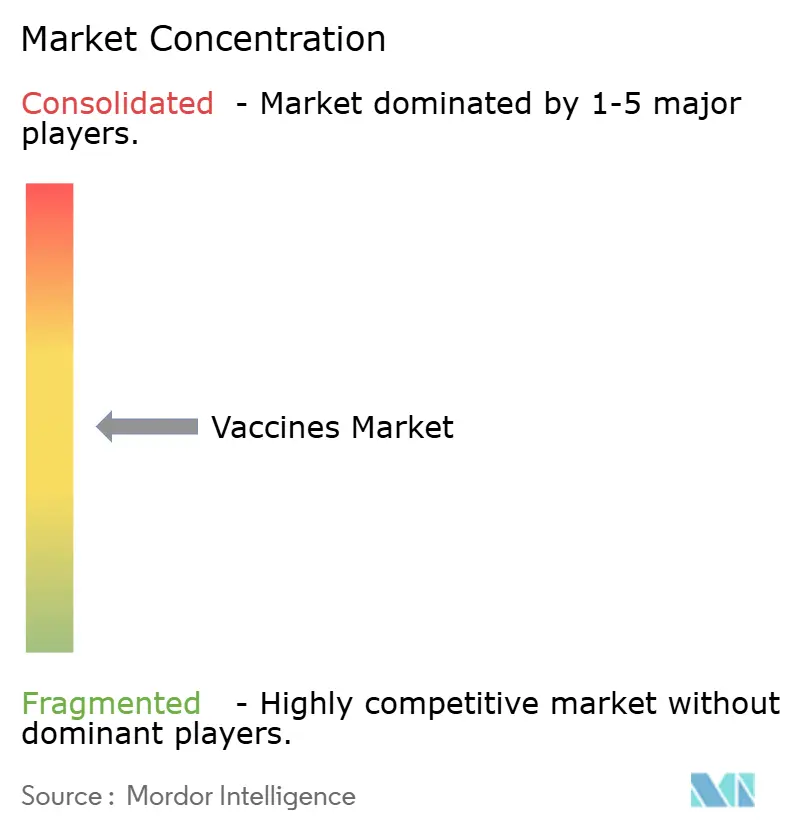
Vaccines Market News
- December 2024: Butantan Institute submitted its single-dose dengue vaccine to Brazil's drug regulatory authority ANVISA for approval, marking a significant development in dengue prevention efforts.
- May 2024: Novavax and Sanofi announced a co-exclusive licensing agreement to co-commercialize COVID-19 vaccines and develop new COVID-19-influenza combination vaccines, demonstrating continued innovation in vaccine development.
- April 2024: Bavarian Nordic made its FDA-approved Mpox vaccine JYNNEOS commercially available in the United States, expanding access through additional procurement, reimbursement, and distribution pathways.
- January 2024: Dr. Reddy's Laboratories began promoting and distributing Sanofi's vaccine brands in India, including Hexaxim, Pentaxim, Tetraxim, Menactra, FluQuadri, Adacel, and Avaxim 80U, with combined sales of about USD 51 million.
- January 2024: Pfizer gained positive opinion from CHMP for its 20-Valent Pneumococcal Conjugate Vaccine (20vPnC), offering broad coverage against pneumococcal disease.
Vaccines Market Report - Table of Contents
1. INTRODUCTION
- 1.1 Study Assumptions and Market Definition
- 1.2 Scope of the Study
2. RESEARCH METHODOLOGY
3. EXECUTIVE SUMMARY
4. MARKET DYNAMICS
- 4.1 Market Overview
-
4.2 Market Drivers
- 4.2.1 Increasing Prevalence of Chronic Diseases
- 4.2.2 Expanding Health Insurance Coverage
- 4.2.3 Technological Advancement
-
4.3 Market Restraints
- 4.3.1 Product Recalls and Lawsuits
- 4.3.2 Limited Availability of Trained Staff
-
4.4 Porter's Five Force Analysis
- 4.4.1 Threat of New Entrants
- 4.4.2 Bargaining Power of Buyers/Consumers
- 4.4.3 Bargaining Power of Suppliers
- 4.4.4 Threat of Substitute Products
- 4.4.5 Intensity of Competitive Rivalry
5. MARKET SEGMENTATION (Market Size by Value - USD)
-
5.1 By Technology
- 5.1.1 Conjugate Vaccines
- 5.1.2 Inactivated Vaccines
- 5.1.3 Live Attenuated Vaccines
- 5.1.4 mRNA Vaccines
- 5.1.5 Recombinant Vaccines
- 5.1.6 Toxoid Vaccines
- 5.1.7 Viral Vector Vaccines
-
5.2 By Type
- 5.2.1 Monovalent Vaccines
- 5.2.2 Multivalent Vaccines
-
5.3 By Disease Indication
- 5.3.1 DTP
- 5.3.2 Hepatitis
- 5.3.3 Herpes Zoster
- 5.3.4 HPV
- 5.3.5 Influenza
- 5.3.6 Meningococcal Disease
- 5.3.7 MMR
- 5.3.8 Pneumococcal Disease
- 5.3.9 Polio
- 5.3.10 Rotavirus
- 5.3.11 RSV
- 5.3.12 Other Disease Indications
-
5.4 By Route of Administration
- 5.4.1 Oral Administration
- 5.4.2 Parenteral Administration
- 5.4.3 Other Routes of Administration
-
5.5 By End-User
- 5.5.1 Adult Vaccines
- 5.5.2 Pediatric Vaccines
-
5.6 By Geography
- 5.6.1 North America
- 5.6.1.1 United States
- 5.6.1.2 Canada
- 5.6.1.3 Mexico
- 5.6.2 Europe
- 5.6.2.1 Germany
- 5.6.2.2 United Kingdom
- 5.6.2.3 France
- 5.6.2.4 Italy
- 5.6.2.5 Spain
- 5.6.2.6 Rest of Europe
- 5.6.3 Asia-Pacific
- 5.6.3.1 China
- 5.6.3.2 Japan
- 5.6.3.3 India
- 5.6.3.4 Australia
- 5.6.3.5 South Korea
- 5.6.3.6 Rest of Asia-Pacific
- 5.6.4 Middle East and Africa
- 5.6.4.1 GCC
- 5.6.4.2 South Africa
- 5.6.4.3 Rest of Middle East and Africa
- 5.6.5 South America
- 5.6.5.1 Brazil
- 5.6.5.2 Argentina
- 5.6.5.3 Rest of South America
6. COMPETITIVE LANDSCAPE
-
6.1 Company Profiles
- 6.1.1 AstraZeneca Plc
- 6.1.2 CSL
- 6.1.3 Emergent BioSolutions
- 6.1.4 GlaxoSmithKline
- 6.1.5 Johnson & Johnson
- 6.1.6 Merck & Co. Inc.
- 6.1.7 Moderna, Inc
- 6.1.8 Pfizer, Inc
- 6.1.9 Sanofi SA
- 6.1.10 Serum Institute of India Pvt Ltd
- *List Not Exhaustive
7. MARKET OPPORTUNITIES AND FUTURE TRENDS
Vaccines Industry Segmentation
As per the report's scope, vaccines are biological preparations designed to provide immunity against specific diseases. They stimulate the body's immune system to recognize and combat pathogens, such as viruses or bacteria. Vaccines are crucial in preventing infectious diseases, reducing mortality rates, and promoting public health globally. They are administered through various methods, including injections and oral doses.
The vaccine market is segmented by technology, type, disease indication, route of administration, end-user, and geography. On the basis of technology, the market is segmented into conjugate vaccines, inactivated vaccines, live attenuated vaccines, mRNA vaccines, recombinant vaccines, toxoid vaccines, and viral vector vaccines. Based on type, the market is segmented into monovalent vaccines and multivalent vaccines. By disease indication, the market is segmented into DTP, hepatitis, herpes zoster, HPV, influenza, meningococcal disease, MMR, pneumococcal disease, polio, rotavirus, RSV, and other disease indications. On the basis of the route of administration, the market is segmented into oral administration, parenteral administration, and other routes of administration. By end-user, the market is bifurcated into adult vaccines and pediatric vaccines. On the basis of geography, the market is segmented into North America, Europe, Asia-Pacific, Middle East and Africa, and South America. The report offers the value (in USD) for the above-mentioned segments.
| By Technology | Conjugate Vaccines | ||
| Inactivated Vaccines | |||
| Live Attenuated Vaccines | |||
| mRNA Vaccines | |||
| Recombinant Vaccines | |||
| Toxoid Vaccines | |||
| Viral Vector Vaccines | |||
| By Type | Monovalent Vaccines | ||
| Multivalent Vaccines | |||
| By Disease Indication | DTP | ||
| Hepatitis | |||
| Herpes Zoster | |||
| HPV | |||
| Influenza | |||
| Meningococcal Disease | |||
| MMR | |||
| Pneumococcal Disease | |||
| Polio | |||
| Rotavirus | |||
| RSV | |||
| Other Disease Indications | |||
| By Route of Administration | Oral Administration | ||
| Parenteral Administration | |||
| Other Routes of Administration | |||
| By End-User | Adult Vaccines | ||
| Pediatric Vaccines | |||
| By Geography | North America | United States | |
| Canada | |||
| Mexico | |||
| Europe | Germany | ||
| United Kingdom | |||
| France | |||
| Italy | |||
| Spain | |||
| Rest of Europe | |||
| Asia-Pacific | China | ||
| Japan | |||
| India | |||
| Australia | |||
| South Korea | |||
| Rest of Asia-Pacific | |||
| Middle East and Africa | GCC | ||
| South Africa | |||
| Rest of Middle East and Africa | |||
| South America | Brazil | ||
| Argentina | |||
| Rest of South America | |||
Vaccines Market Research Faqs
How big is the Vaccines Market?
The Vaccines Market size is expected to reach USD 83.95 billion in 2025 and grow at a CAGR of 6.47% to reach USD 114.85 billion by 2030.
What is the current Vaccines Market size?
In 2025, the Vaccines Market size is expected to reach USD 83.95 billion.
Which is the fastest growing region in Vaccines Market?
Asia Pacific is estimated to grow at the highest CAGR over the forecast period (2025-2030).
Which region has the biggest share in Vaccines Market?
In 2025, the North America accounts for the largest market share in Vaccines Market.
What years does this Vaccines Market cover, and what was the market size in 2024?
In 2024, the Vaccines Market size was estimated at USD 78.52 billion. The report covers the Vaccines Market historical market size for years: 2019, 2020, 2021, 2022, 2023 and 2024. The report also forecasts the Vaccines Market size for years: 2025, 2026, 2027, 2028, 2029 and 2030.
Vaccines Industry Report
Statistics for the 2025 Vaccines market share, size and revenue growth rate, created by Mordor Intelligence™ Industry Reports. Vaccines analysis includes a market forecast outlook for 2025 to 2030 and historical overview. Get a sample of this industry analysis as a free report PDF download.




